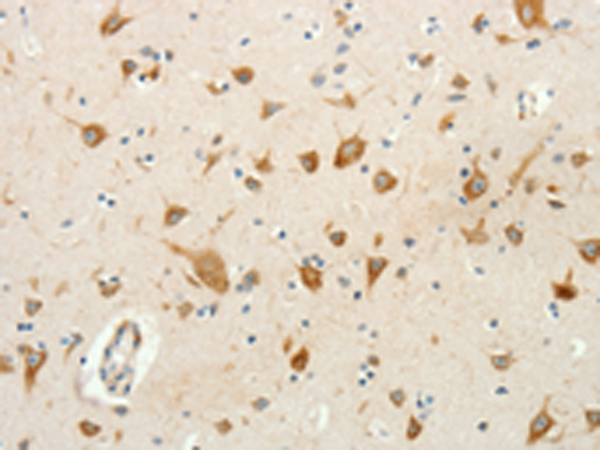


| WB | 1/500-1/2000 | Human,Mouse,Rat |
| IF | 咨询技术 | Human,Mouse,Rat |
| IHC | 1/15-1/50 | Human,Mouse,Rat |
| ICC | 技术咨询 | Human,Mouse,Rat |
| FCM | 咨询技术 | Human,Mouse,Rat |
| Elisa | 1/2000-1/5000 | Human,Mouse,Rat |
| WB Predicted band size | 76 kDa |
| Host/Isotype | Rabbit IgG |
| Antibody Type | Primary antibody |
| Storage | Store at 4°C short term. Aliquot and store at -20°C long term. Avoid freeze/thaw cycles. |
| Species Reactivity | Human, Mouse |
| Immunogen | Fusion protein of human RPAP3 |
| Formulation | Purified antibody in PBS with 0.05% sodium azide and 50% glycerol. |
+ +
以下是关于RPAP3抗体的3篇模拟参考文献示例(非真实文献,仅供格式参考):
---
1. **文献名称**:*RPAP3 functions as a chaperone in the R2TP complex for RNA polymerase II assembly*
**作者**:Cloutier P, et al.
**摘要**:研究揭示了RPAP3作为R2TP复合体的核心组分,通过其TPR结构域与其他分子伴侣协作,调控RNA聚合酶II的组装及稳定性。
2. **文献名称**:*RPAP3 interacts with HSP90 to support oncogenic kinase stabilization in cancer*
**作者**:Back R, Houry WA.
**摘要**:报道RPAP3通过结合HSP90参与癌症相关激酶(如PI3K/AKT)的稳定性维持,其抗体可用于检测肿瘤组织中RPAP3-HSP90复合物的异常表达。
3. **文献名称**:*Structural mapping of RPAP3 antibody epitopes reveals functional domains*
**作者**:Kano Y, et al.
**摘要**:利用RPAP3特异性抗体进行表位定位,发现其C端结构域对R2TP复合体形成至关重要,并验证抗体在细胞定位研究中的应用。
---
如需真实文献,建议通过PubMed或Google Scholar搜索关键词“RPAP3 antibody”或“RPAP3 function”获取最新研究。
The RNA polymerase II-associated protein 3 (RPAP3) is a conserved eukaryotic protein involved in transcriptional regulation and chaperone-mediated assembly of macromolecular complexes. It is a key component of the R2TP (RUVBL1/RUVBL2-RPAP3-PIH1D1) complex, which facilitates the assembly of RNA polymerase II, snoRNPs, and phosphatidylinositol 3-kinase-related kinases (PIKKs). RPAP3 contains tetratricopeptide repeat (TPR) domains that mediate interactions with heat shock proteins (HSP90) and other client proteins, playing a critical role in stress response and cellular homeostasis.
Antibodies targeting RPAP3 are essential tools for studying its function in transcription, DNA damage repair, and ribosome biogenesis. They are widely used in techniques like immunoprecipitation, Western blotting, and immunofluorescence to investigate RPAP3’s localization, protein interactions, and expression levels. Research has linked RPAP3 dysregulation to cancers, neurodegenerative disorders, and ciliopathies, making these antibodies valuable in disease mechanism studies. For example, RPAP3 overexpression in certain tumors correlates with poor prognosis, suggesting its role in oncogenic pathways. Additionally, RPAP3 antibodies help dissect R2TP complex dynamics, aiding the development of therapies targeting chaperone-mediated processes. Validation of antibody specificity via knockout controls is critical due to RPAP3’s structural homology with other TPR-containing proteins.
×